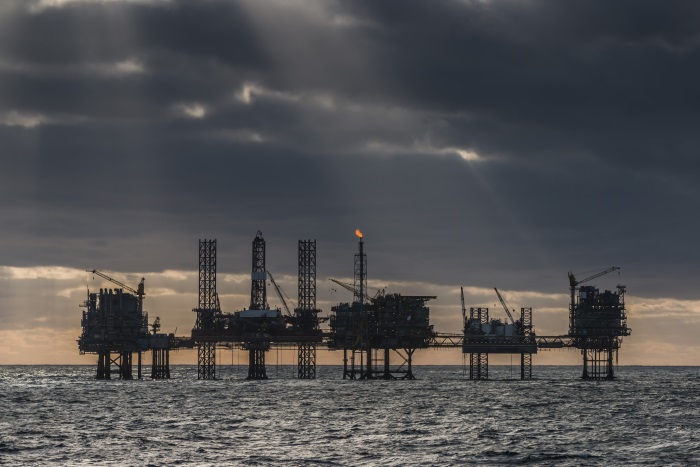Abandonment of Offshore Oil and Gas Fields
Over the coming decades, a substantial number of oil and gas wells in the Danish sector of the North Sea will have to be plugged and abandoned. DTU Offshore delivers R&D for this monumental task through our Abandonment programme.

Plugging and abandoning wells in the Danish North Sea will not only be cost and time consuming; it may also have a large impact on the environment both in the short and long term. The Centre is running a research programme with focus on the specific challenges in the Danish North Sea with the aim of robust and cost-effective abandonment for short- and long-term environmental protection.
Well barrier materials
Ensuring long term environmental protection after well abandonment requires well barriers, which retains integrity over time. Cement is the traditional material for abandonment of oil and gas wells and research is therefore on-going to understand what happens in abandonment cement and how the flow potential in the cement changes over time.
Cement might develop cracks after installation which is detrimental for the integrity of the well barrier. Several approaches for healing or repair of these cracks are being researched, stretching from self-healing of the cracks, development of crystals in the cracks, and injection of a glass-based material into the cracks.
Abandonment of wells with scale
A significant amount of the wells in the Danish North Sea suffers from scale build-up preventing the installation of barriers. This means that prior to well abandonment a lot of time and money is spent on scale removal. Having removed the scale, it is transported to shore for permanent storage.
Research is focusing on developing pumpable barrier solutions to avoid scale removal for temporary well plugging as part of the initial well abandonment process. Several potential solutions are being researched and at the moment a modular polymer plug is being prototyped. This plug is be developed specifically for the conditions and operations in the Danish North Sea.
For permanent abandonment barriers in wells with scale, research is investigating a solution where the scale becomes an integrated part of the well barrier. The hypothesis is that the cement barrier can be set inside the scale and a method for strengthening the scale is being developed, to ensure that the scale has similar permeability and strength as the cement.
Overburden
When the oil and gas wells were drilled, focus was on reaching the reservoir and less attention was put on collecting data in the overburden. When abandoning the wells, it must be ensured that all zones with flow potential are isolated and therefore a more in-depth understanding of the overburden is required.
Researchers are therefore working on understanding the flow potential in shallow permeable zones with specific focus on the Diatomite zones. This research has, amongst other things, developed a novel approach where frequency dispersion of electrical resistivity downhole logs is used as a tool for predicting pore size, which in combination with porosity data will allow matrix permeability to be estimated.
The oil and gas wells are drilled through several formations with natural swelling capabilities. Research is therefore investigating where these shales can form part of a well barrier and thereby ensuring integrity over geological time. As cores are not available through these formations, a method has been developed to use drill cuttings for investigating the swelling capability. In addition, methods for initiating shale swelling are also being developed.
Surveillance of abandoned wells
Having abandoned the oil and gas wells, monitoring techniques will have to be available for detecting a potential future methane leak, in case of a breach of a well barrier. The aim of this research is to develop a sensor which can detect and measure potential future methane leaks at the water column.
The sensor has been validated at lab conditions and is being patented while work is ongoing to make an offshore pilot test. The developed sensor is able to continuously measure methane dissolved in the water and can at the same time detect CO₂.
Environmental baseline pre-abandonment
Natural seepage of hydrocarbons is occurring across the North Sea and oil and gas wells are often drilled in areas with seepage. Having abandoned the wells, surveillance must be in place to detect potential leaks.
However, if methane is detected during surveillance it must be understood if the detected methane is caused by a leaking well or is natural occurring. Research is establishing a pre- and post-production baseline for the natural hydrocarbon seepage based on geophysical data and shallow cores collected around Gorm and Valdemar platforms, and in addition in an area away from oil and gas fields. At the same time a toolbox for future baselining is being developed.
When an oil or gas field is decommissioned, the installations must be removed from the seabed and up. However, these structures could form a habitat for marine species. It is therefore important to understand the importance of the structures for marine life before they are removed. This project aims at understanding the importance of the structures for the cod communities both with respect to the number of individual cods and the way they use the structures. The project includes offshore data collection around the Skjold platform.
Contact
Charlotte Nørgaard Larsen New Projects Director Danish Offshore Technology Centre Mobile: +45 93511536 clarsen@dtu.dk